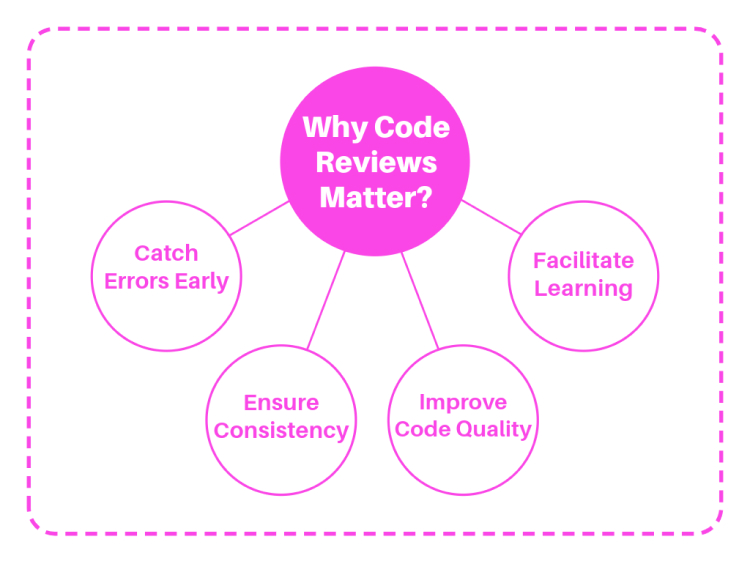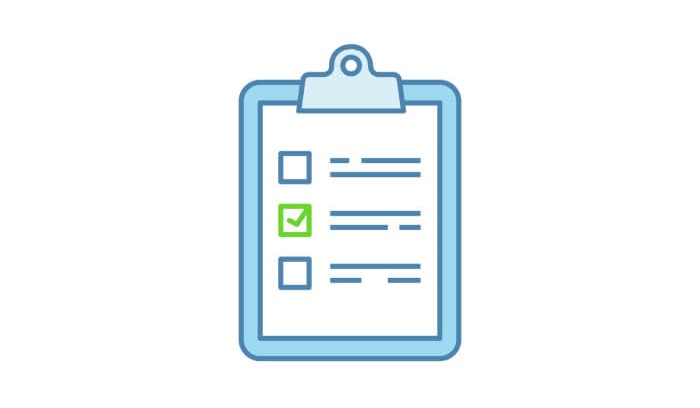Writing clean, secure, and maintainable code is a cornerstone of successful software development. But even the most talented developers can miss something. That’s where code reviews come in – a collaborative process where developers scrutinize each other’s work to identify potential issues and suggest improvements.
This ultimate code review checklist equips you to conduct thorough and effective reviews, boosting your project’s overall code quality. Whether you’re a seasoned developer or just starting out, this checklist provides a roadmap to ensure your code is built to last.
Why Do Code Reviews Matter?
Code reviews are more than just a checkpoint before merging code into the main branch. They play a vital role in maintaining code quality, facilitating knowledge sharing, and reducing the number of bugs that reach production. Let’s now first look at why code reviews are indispensable.

Catch Errors Early
Identifying and fixing errors during the review phase is far more cost-effective than addressing them post-release. The cost of fixing a bug increases exponentially the later it is detected in the development lifecycle. Here’s why catching errors early is crucial:
- Reduced Costs: Fixing issues during the development phase is significantly cheaper compared to after deployment, where the bug might impact end users and require urgent patches.
- Prevents Escalation: Early detection prevents small issues from escalating into larger, more complex problems that can affect other parts of the system.
- Minimizes Rework: Addressing problems during code review means fewer rework cycles, allowing developers to focus on new features and improvements rather than fixing old bugs.
Ensure Consistency
Reviews help maintain coding standards and consistency across the codebase. Consistency is vital for a number of reasons:
- Easier Maintenance: Consistent code is easier to read, understand, and maintain. This is especially important in large projects where multiple developers are involved.
- Reduces Misunderstandings: When the code follows a uniform style guide, it reduces the likelihood of misunderstandings and errors.
- Promotes Best Practices: Regular code reviews reinforce the adoption of best practices and coding standards across the team, ensuring everyone is on the same page.
Improve Code Quality
Regular reviews promote best practices and lead to higher-quality code. This is achieved through several mechanisms:
- Peer Pressure: Knowing that peers will review the code can motivate developers to adhere to higher standards.
- Collective Wisdom: Code reviews leverage the collective experience and knowledge of the team, leading to better design decisions and solutions.
- Error Reduction: Regular scrutiny ensures that potential errors are caught and fixed before they become major issues.
Facilitate Learning
Both reviewers and authors learn from the feedback process, fostering a culture of continuous improvement. Here’s how code reviews contribute to team learning:
- Knowledge Sharing: Code reviews are an excellent way for team members to share knowledge and learn from each other’s expertise and experience.
- Improves Skills: Reviewers can spot innovative solutions and techniques they might not have considered, while authors receive constructive feedback to improve their coding skills.
- Encourages Collaboration: The review process fosters a collaborative environment where team members work together to improve the code, leading to better team dynamics and project outcomes.
Building a Bulletproof Code Review Checklist
An effective code review checklist should encompass various aspects, categorized into these key areas:
- Functionality
- Readability & Maintainability
- Security
- Performance
- Testing
- Documentation
Functionality
- Does the code achieve its intended purpose? Verify that the code implements the specified requirements and delivers the expected functionality.
- Are edge cases considered? Ensure the code behaves as intended under various user inputs and scenarios, including boundary conditions and error situations.
- Does the code integrate seamlessly with other components? Review how the code interacts with existing modules and ensure proper data flow within the system.
Readability & Maintainability
- Is the code well-formatted and easy to understand? Proper indentation, spacing, and meaningful variable/function names enhance readability for future modifications.
- Is the code modular and organized? Breaking down complex logic into smaller, reusable functions improves maintainability and reduces duplication.
- Are comments clear and concise? Comments should explain non-obvious code sections and document design decisions for future reference.
Security
- Does the code adhere to secure coding practices? This includes validating user input, preventing SQL injection attacks, and properly handling sensitive data.
- Are potential security vulnerabilities identified? Review for common security pitfalls like insecure password storage and buffer overflows.
- Are access controls properly implemented? Ensure only authorized users can access and modify data based on their permissions.
Performance
- Is the code optimized for efficiency? Review for potential bottlenecks and areas for performance improvements, especially in critical code paths.
- Are resource allocations managed effectively? Minimize memory leaks and excessive resource usage to ensure smooth system operation.
- Are there opportunities for caching or data structure optimization? Explore caching mechanisms and efficient data structures to improve code performance.
Testing
- Are there sufficient unit tests to cover the code functionality? Unit tests ensure individual code components function as expected.
- Are integration tests in place to verify interaction with other modules? Integration tests check how different parts of the system work together.
- Is there a plan for regression testing after modifications? Ensure previously working features remain functional after code changes.
Documentation
- Is the code purpose clearly documented? A brief overview of the code’s functionality helps developers understand its role within the system.
- Are APIs documented with clear examples? API documentation is crucial for developers who need to interact with the code.
- Are design decisions and trade-offs documented? Documenting the reasoning behind design choices aids future maintenance and understanding.
By systematically applying this checklist, you can improve code quality, maintainability, and security, ensuring a smoother integration process and a more robust codebase.
Remember: This checklist serves as a starting point. You can customize it based on your specific project requirements, coding standards, and programming language.
Using This Checklist in GitHub Pull Requests
When creating or reviewing a pull request on GitHub, use this checklist to ensure the proposed changes meet all necessary criteria:
- Before Creating a Pull Request:
- Ensure your code meets the functionality, readability, security, performance, testing, and documentation standards outlined in the checklist.
- Verify integration with other components and consider edge cases.
- During the Pull Request Review:
- Use the checklist as a guide to review the proposed changes thoroughly.
- Collaborators can provide feedback and suggest improvements based on the checklist criteria.
- Reviewers should check that all necessary tests are in place and the documentation is adequate.
- After the Review:
- Address any feedback from reviewers by making necessary changes and updating the pull request.
- Ensure all status checks pass before merging the pull request.
- Link the pull request to relevant issues to track progress and close issues automatically upon merging.
Summary of the Checklist
Let’s summarize our checklist in the table below:
| Category | Key Points |
| Functionality | Verify the code meets requirements, ensure edge cases are considered, check seamless integration with other components |
| Readability and Maintainability | Ensure proper formatting and clear variable/function names, maintain modular and organized code, include clear and concise comments |
| Security | Adhere to secure coding practices, identify potential security vulnerabilities, implement proper access controls |
| Performance | Optimize code for efficiency, manage resource allocations effectively, explore opportunities for caching and data structure optimization |
| Testing | Ensure sufficient unit tests, conduct integration tests, plan for regression testing |
| Documentation | Clearly document the code’s purpose, provide clear API documentation, document design decisions and trade-offs |
AI Tools in Action: Enhancing Code Review
Code reviews should focus on the big picture, offering constructive and manageable feedback. Rather than overwhelming developers with numerous minor changes, aim to provide a few key suggestions that significantly improve the code. Minor errors in grammar and naming conventions can inflate feedback and complicate its acceptance. AI can help by minimizing these low-level mistakes, streamlining readability and naming issues, and offering a cleaner starting point. Now, AI tools can also be integrated into our pull requests, making our work easier and more efficient.
Artificial intelligence (AI) tools have become increasingly essential for streamlining and enhancing various aspects of software development. One such area is code review, where AI-powered tools like Qodo Merge (formerly PR-Agent) can revolutionize the process. By harnessing the capabilities of machine learning algorithms, Qodo Merge (formerly PR-Agent) automates the meticulous analysis and assessment of pull requests, providing developers with tailored feedback and actionable insights.
With features such as tailored review sections, actionable code guidance, and custom labels for compliance assurance, Qodo Merge (formerly PR-Agent) not only expedites the review process but also elevates the overall code quality. By integrating AI tools like Qodo Merge (formerly PR-Agent) into our code review checklist, we can further optimize our development workflow, ensuring that our code is not only clean, secure, and maintainable but also harnesses the power of cutting-edge technology for continuous improvement.









 Ezra Marzel
Ezra Marzel Nathaniel Kenvel
Nathaniel Kenvel
